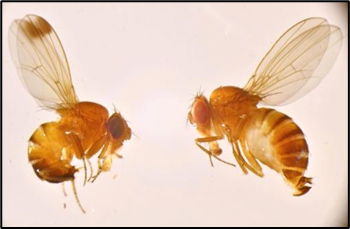Be Ready for Spotted-Wing Drosophila

Spotted-wing drosophila (SWD; Fig 1) has not yet been detected in Wisconsin but has been reported in other Eastern and Midwestern states, including Minnesota. The lack of detection this far does not mean that SWD is not yet active in the state, only that we are not monitoring where they may be breeding, such as in wild hosts in woodland areas, at this time. The warm and humid weather we have been experiencing this spring should lead to earlier detection and possibly higher populations this year but our limited monitoring this year does not allow us to compare with previous years.
Regardless, at this time, we strongly recommend that farms growing strawberry, raspberry, blueberries, and other soft fruits begin monitoring for SWD as soon as possible and finalize their management plans for SWD. Commercial or homemade traps and baits should be deployed at this time, with one per acre and checked at least once or twice a week. Commercial traps and lures can be purchased from companies such as Great Lakes IPM. To make your own trap, use a 32 oz. clear plastic deli cup with a lid, drill or melt 3/16” holes around the top of the cup to allow SWD flies to enter. Traps can be baited with either ~1 inch of apple cider vinegar, or a yeast-sugar mix (1 Tbsp. active dry yeast: 4 Tbsp. sugar: 12 oz. water). Add a couple drops of unscented dish soap to prevent flies from escaping.
Once fruit is ripening and traps catch at least 1 SWD/trap/week, you are advised to implement chemical controls to manage SWD in your fruit as this is the action threshold. Another option we recommend to strawberry and grape growers is to sample suspected fruit to look for the presence of larvae (see previous article here). We recommend checking fruit twice a week, crushing the fruit and looking inside for SWD larvae, or using the salt test method.
If you find larvae in your fruit, sanitation and 2-day harvest schedule methods should be implemented and were discussed in a previous article. Other management methods, such as physical barrier, refrigeration, and chemical control were discussed in our article on organic management of SWD and in this comprehensive organic management publication. Other strategies that can be used in conventional management are also discussed in a previous article.
Insecticides options for organic production rely primarily on Spinosad IRAC 5 (Entrust) as the sole compound with excellent efficacy. Spinosad should be rotated with either Pyrethrum IRAC 3A (Pyganic) or the chromobacterium Grandevo for resistance management.
Conventional insecticides rated excellent for SWD control include Pyrethroids IRAC 3A (e.g., Brigade, Capture, Mustang Maxx, Hero, Danitol), Diamides IRAC 28 (e.g., Exirel), Spinosyns IRAC 5 (e.g., Entrust, Delegate), and organophosphate IRAC 1B (e.g., Malathion). Please remember to rotate amongst different classes of insecticides or IRAC groups to prevent insecticide resistance. More insecticides are available for SWD control and not all are registered on all small fruit crops, so please check the labels to make sure the crop you intend to spray is present on the label and refer to the Midwest Fruit Pest Management Guide for more information.
Happy growing season!
This article was posted in Berries, Insects and tagged Spotted Wing Drosophila, SWD.
